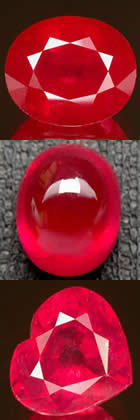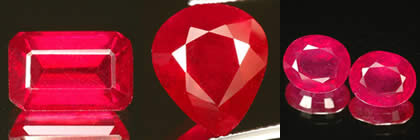 If you're interested in rubies, you may have noticed how much of the ruby being sold by reputable dealers is described as "fracture-filled." Why is there so much of this material on the market? Is it really any good? Or should it be avoided?
If you're interested in rubies, you may have noticed how much of the ruby being sold by reputable dealers is described as "fracture-filled." Why is there so much of this material on the market? Is it really any good? Or should it be avoided?
To understand why these rubies are being offered, it's important to understand something about the world demand for ruby, the supply of material, and the recent history of prices.
Though ruby and sapphire are both corundum, ruby is in fact much rarer than sapphire. The world demand for ruby far exceeds the supply, and some of the famous ruby deposits, such as those in Thailand and Cambodia, have been completely worked out. The same is true for the famous ruby mines in Mogok in Burma; the production from Mogok has been reduced to a mere trickle.
In the last ten years the main sources for ruby have been the Mong Hsu deposits in Burma (discovered in 1992), and the Madagascar mines (discovered in 2000). The Mong Hsu deposits were very significant, but the Mong Hsu rubies require heat treatment to improve the color. Sizes have already declined and it is now rare to see Mong Hsu rubies over 1 carat. The Madagascar mines yield some larger material, but the demand is so enormous that the supply quickly disappears.
In 2004, a gem lab in Chanthaburi, Thailand came up with an innovation that increased the supply of ruby on the market. They developed a technique to improve the appearance of rubies of good color, primarily from Madagascar, that are disfigured by fissures or surface cracks. These previously unsaleable gems could be repaired using heat treatment with lead glass. The refractive index of corundum and lead glass are very similar, allowing light to travel through the stone, improving the color and clarity.
Many of the rubies that could be repaired with this new fracture-filling technique are of impressive size, with many stones over 5 carats. Since the treatment is easy to detect, it is almost always disclosed and the price is adjusted accordingly. So these fracture-filled rubies sell at a fraction of the cost of untreated rubies of similar color. In fact you won't find 10 or 15 carat untreated rubies in the market at all, and very few that have been only heat treated.
 Should you buy a fracture-filled ruby? Technically, the treatment appears to be effective. Many of the fracture-filled stones look very good indeed. The Asian Institute of Gemology (AIGS) tested samples for durability and found them to be more durable than a typical emerald that has been fracture-filled with oil or resin. AIGS advises against excessive heating with a jeweler's torch, but found no negative effects from cleaning with detergents or ultrasonic devices. They advise that hydrofluoric acid should not be used on these gems, and that any recutting or repolishing should be performed with care.
Should you buy a fracture-filled ruby? Technically, the treatment appears to be effective. Many of the fracture-filled stones look very good indeed. The Asian Institute of Gemology (AIGS) tested samples for durability and found them to be more durable than a typical emerald that has been fracture-filled with oil or resin. AIGS advises against excessive heating with a jeweler's torch, but found no negative effects from cleaning with detergents or ultrasonic devices. They advise that hydrofluoric acid should not be used on these gems, and that any recutting or repolishing should be performed with care.
First Published: May-08-2008
© 2005-2010 GemSelect.com all rights reserved.
Reproduction (text or graphics) without the express written consent of GemSelect.com (SETT Company Ltd.) is strictly prohibited.
That is really good article,
ReplyDeleteHii Zhan Jwewllery
ReplyDeleteyou wrote such an amazing things , i have read maximum blog written by you.
could you write some blogs on silver gemstone rings , gemstone earrings, pendants